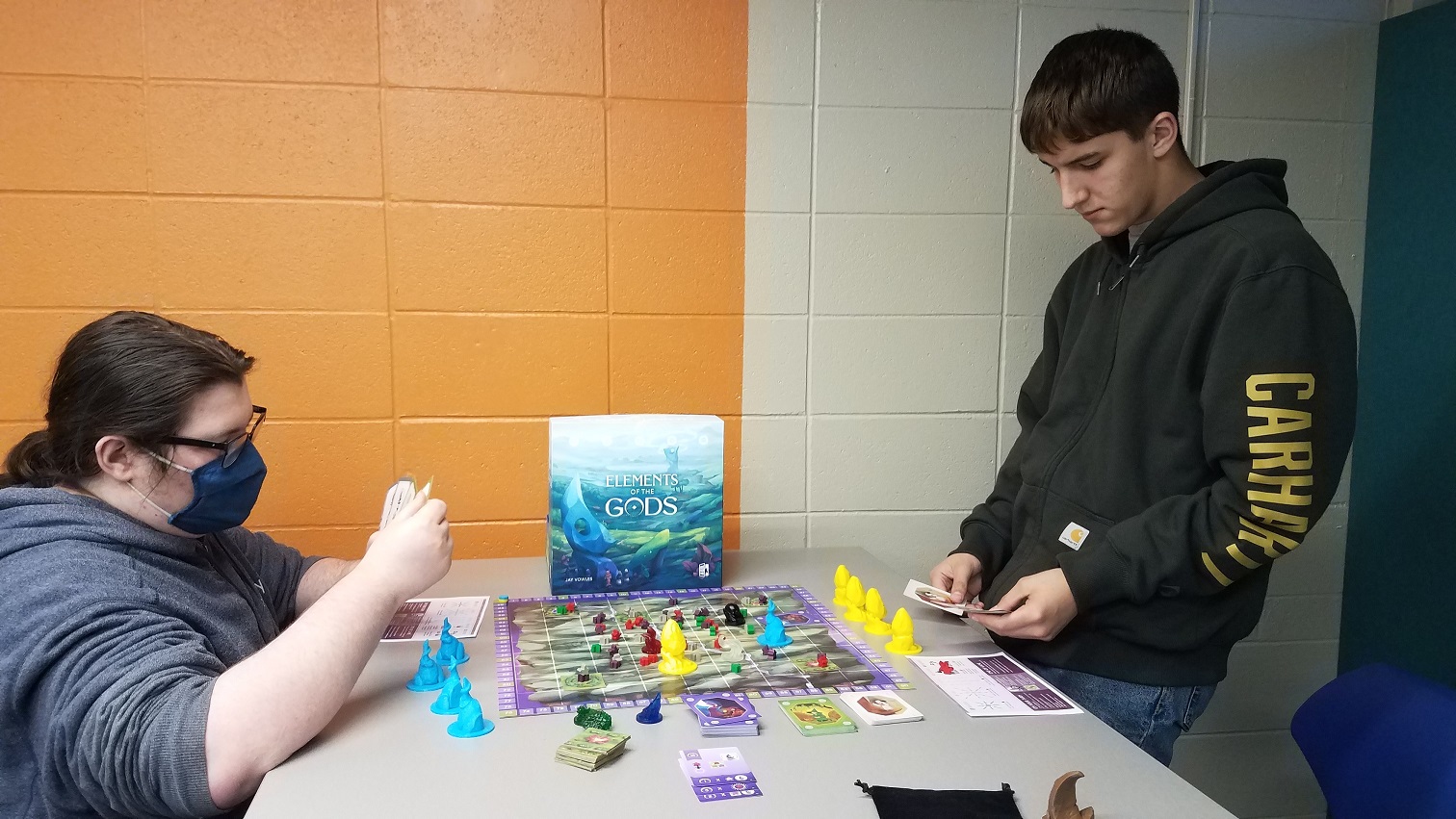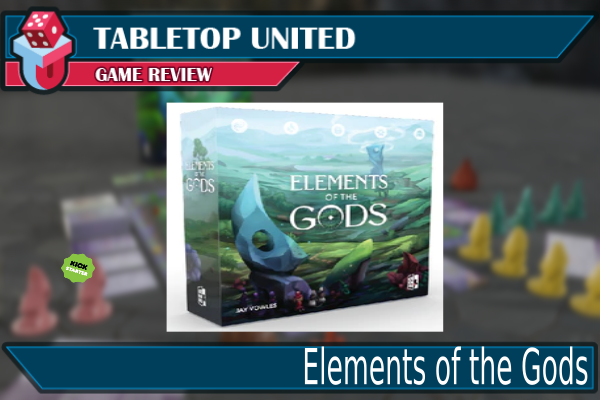Elements of the Gods
Designer: Jay Vowles
Artist: Apolline Etienne, Brigette Indelicato
Publisher: Side Room Games
Year Published: Kickstarter 2020
No. of Players: 1-5
Ages: 14+
Playing Time: 30-90 minutes
Main mechanic / Theme: Action drafting, area influence, abstract
Use the chaos of the Elements to grow your followers, build monuments, and grow gardens and become all-powerful in Elements of the Gods
Find more info on BoardGameGeek.com
https://www.boardgamegeek.com/boardgame/312911/elements-gods
Find more info on Kickstarter
https://www.kickstarter.com/projects/sideroomgames/elements-of-the-gods
Disclaimer: Side Room Games provided a prototype copy of the game for this review. Components, design, artwork, and rules may change between the printing of this review and time of publication.
Overview:
As a god growing your power and influence at the dawn of civilization, you must use the powers of five elements to influence your followers (meeples). Ask them to build you gardens and monuments and perform rites and rituals in your honor. The power of the elements are yours to command as your followers praise your name in victory. Each follower is either a stonemason, a gardener, mystic, or zealot, and each plays a vital role in gaining influence for you in the play area. At game end, players score points based on the location of your followers in relation to monuments and gardens on the game board.
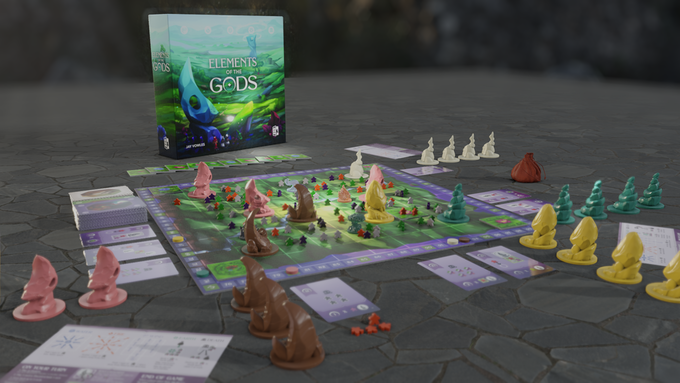
Gameplay and mechanics:
Elements of the Gods is played in turns and rounds. After all five elements have been played, a round ends, and a new round starts. Players can perform one of three actions on their turn to manipulate the game board and the worshippers and to set up for end-game scoring.
On a player’s turn, choose to place an element on the game board and resolve the effect of that element, play a card from hand OR discard, and lastly, a player can draw back up to five cards. Players may end up with more than five turns since elements do not have to be played.
A game of Elements will end when a single player plays five divinity cards.
Elements of the Gods includes five different elements used to influence the worshippers on the game board. Elements can NOT be placed on a garden, on a monument, or in the same space as another element. The five elements available to choose from are WATER, FIRE, WIND, EARTH, and DEATH. Each element has a specific effect that must be followed. Choose wisely, as worshipper location is important when trying to place monuments, gardens, and scoring victory points.
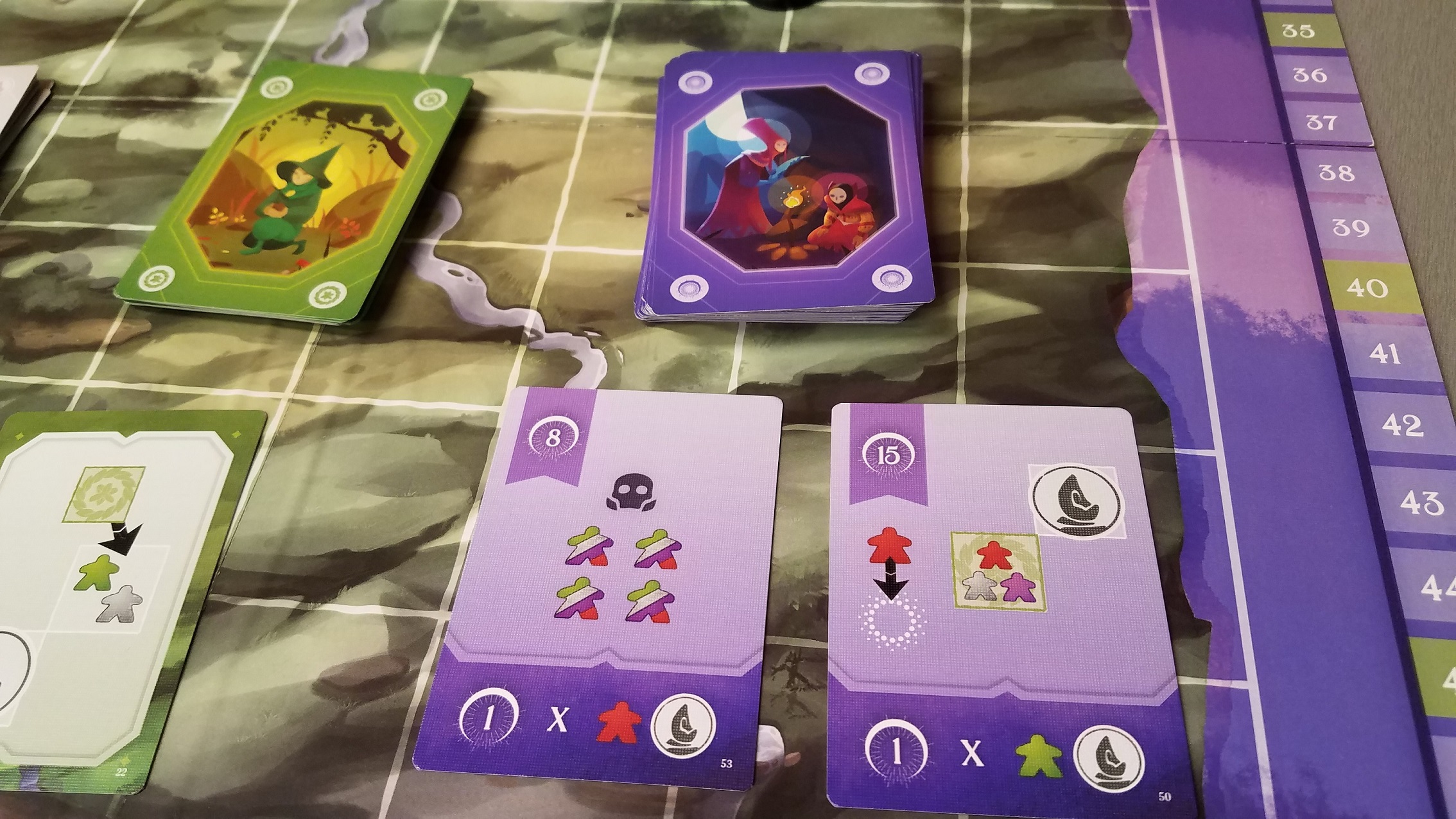
When WATER is placed, one type of worker is pulled towards that element as a giant whirlpool gathers the meeples to that location.
The FIRE element is the opposite, and forces one type of worshipper to move one space away from the raging inferno.
When you place WIND, you choose one type of worshipper and the wind pushes all worshippers of that type one space in the same direction- The cyclone is so strong that they either get blown to a new location or they run scared of the power of the wind.
EARTH represents renewal and birth. When you place the EARTH element, draw five worshippers from the bag and place them in the same space as you placed the EARTH element. Earth does have a slight exception to the placement rule, though. You may place the EARTH element on a garden space. You may pay worshippers from your own afterlife space, if you have any, and place them in place of worshippers drawn from the bag. Essentially, EARTH brings forth new life and brings forth new worshippers to do your bidding.
The last element is DEATH. When DEATH is placed, destroy all worshippers in that space. Choose two workers to put into your personal afterlife space and the rest are returned to the bag. DEATH represents sickness, dying, or other means of loss of life.
As elements force worshippers to move all over the board, there are a few things to keep in mind. Worshippers can never be in a monument space. So, if a worshipper runs away from FIRE into a monument space, that worshipper doesn’t move. Movement off the edge of the board isn’t allowed either- so those crazy worshippers just have to stay still. Lastly, when choosing to move worshippers, they must be placed in a legal space if possible. Those pesky worshippers just can’t sit around and wait for another element to come along.
Card use in Elements of the Gods is important. As one of the actions is to play a card OR discard a card, you have to choose wisely which to do. Three card types are Monument cards, Garden cards, and Divinity cards. Monument cards allow you to build monuments on locations with specific worshippers. Garden cards allow you to add a garden tile to the board based on the pattern of worshippers present. Respectfully, Monument cards have a stonemason and one other worshipper type, and the Garden cards include a gardener and another worshipper type. Building monuments and gardens scores five points. However, individual players score 5 points on monument cards for each garden adjacent to it and you will score five points for garden cards for each monument adjacent to that garden. So, placing a garden next to three monuments will score 3 times. But, the five points per monument goes to the owner of the monument.
As more and more gardens and monuments get played, the chances that your placement of a monument or garden will give points to the other players. Herein lies some of the deeper strategy of the game. Players must calculate their risk of giving other players points VS the reward of earning points by building gardens and monuments.
Of course, the idea is that you must use the elements to move the worshippers around to build those monuments and gardens while at the same time, keeping your opponent’s options limited and yielding better options on the board for yourself.
The Divinity cards include Rituals and Smite cards. Divinity cards include two sections- a top part and a bottom part- making them have two uses. This means that you have to decide how to use them- Use them for the end game to score points or for meeting specific requirements to gain souls from zealots which you, in turn, put in your afterlife. You will score points for meeting the requirements of the ritual, though, so there is a benefit to using the card for the top instead of saving it. The other type of Divinity card is the Smite card. You may clear the board of the specific number of worshippers and then claim the points at the top.
The final option to choose from on your turn is to draw back up to five cards and can choose any combination of cards- garden, monument, or divinity- in order to reach that five card hand limit.
The interesting part of the gameplay is that as players decide whether to play an element, garden, monument, or divinity card, the play area is changing. This means that you have to make decisions based on what your opponents do to the board. You can plan and anticipate an action, but that action may need to be changed. You must be adaptable and ready to use a second option as your turn comes around. I think this adds a bit of chance and makes players follow what the competition is doing. You can’t grow your godhood if you don’t pay attention to what the other little gods are doing, right?
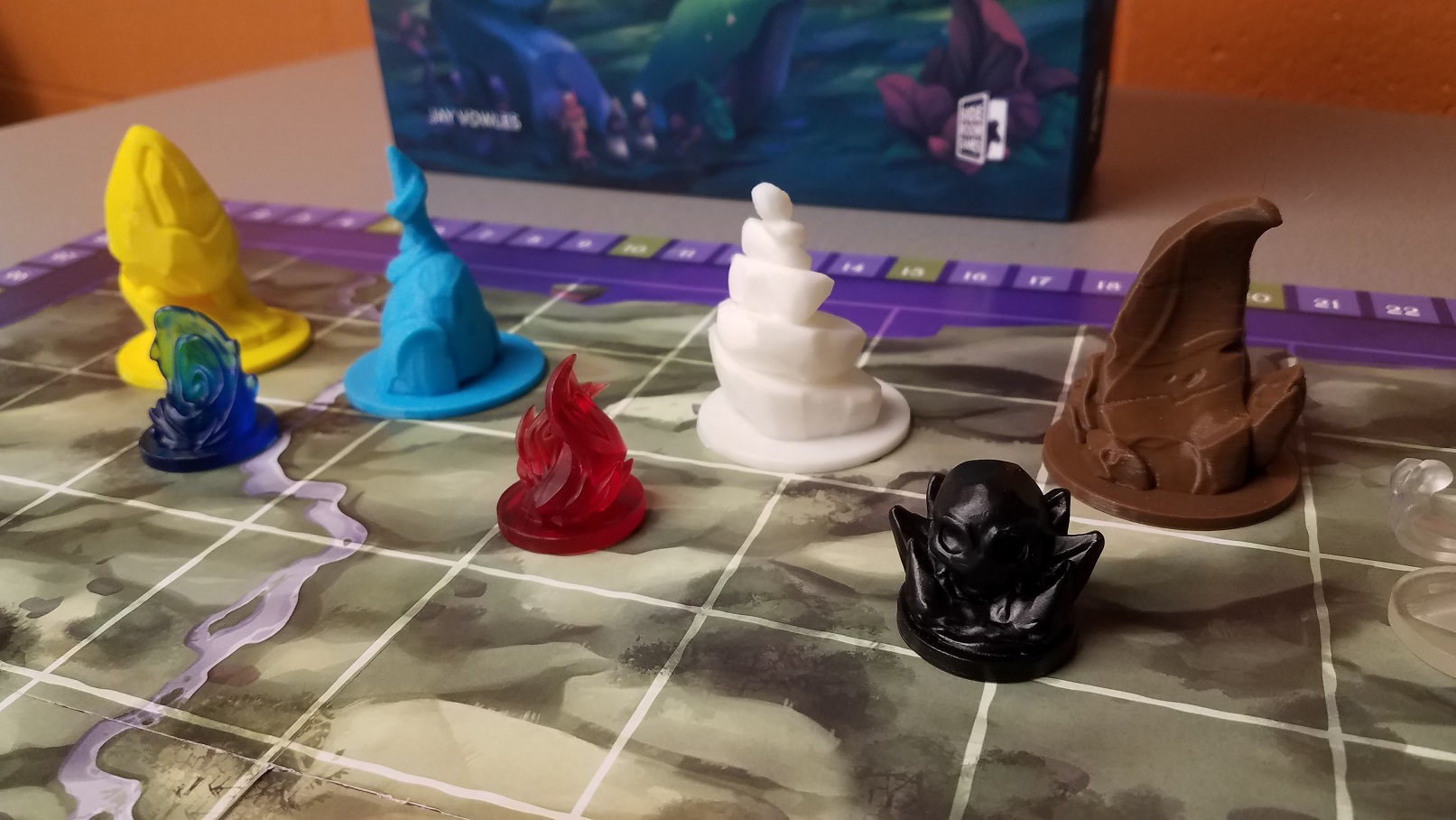
Godhood is reached when any one player plays a 5th Divinity card. Finish the round until no elements remain to choose from. Score the end game bonuses.
Theme, Artwork and Illustration, Graphic Design and Layout
Elements is an abstract game but it does its job well. The meeples on the board are called Worshippers and each is a specific type of worshipper- gardener, stonemason, zealot, and so on. Naming them gives the game flair and a nod to the name of the game. The elements and monuments are full-sized 3d figures- no paper tokens here! The theme is decently integrated into the game play, and both mix well. Actions, choices, and decisions follow the theme of newly born gods trying to build their following.
The board shows a typical countryside with mix of stones and other random bits, but, it has to stay a bit bland so as to not distract from the most interesting aspects of game play- Placing elements, moving worshippers, adding monuments, growing gardens, and MOVING the worshippers due to the elements. The artwork is done well and it doesn’t interfere with the rest of the game elements.
The cards are well done and after you see how the cards are used and played the iconography and layout become a bit more obvious. Things are easy to see, read, and follow. Each card back is unique and are easy to distinguish.I had zero issues with the graphic design and layout. In that regard, Elements of the Gods does a great job.

What worked:
The thing that worked the best for me in Elements of the Gods was actually playing the various elements and seeing how the worshippers moved. I can see how nature takes its toll and forces the people in the countryside to run in fear of the various elements. Some players may find the chaoticness of the game to be a turn-off, but I look at it as a challenge to pay attention to each player’s turn and to continue to play and mitigate what your opponents have done. Sometimes an abstract game doesn’t work for me, but Elements was great in providing a fun and tactical game.
Final thoughts:
Elements is funded, but if you want a cool little strategic game to play with some chaos, don’t hesitate to check out their Kickstarter or follow Side Room Games for a chance to late back. I definitely recommend this game if you like some area management and action-drafting in your games. Plus, placing the elements and moving the meeples all around is fun!
